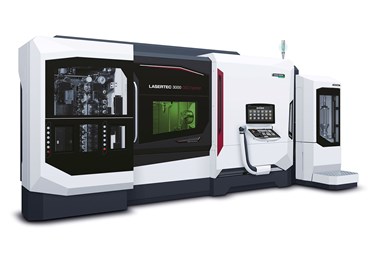Hybrid 3D Printer Offers Five-Axis Simultaneous Machining for Mold and Die Applications
DMG MORI’s Lasertec 3000 DED hybrid 3D printer offers process integration by combining laser deposition welding with five-axis, turn-mill machining in one setup.
DMG MORI’s latest hybrid 3D printer offers increased application possibilities by providing easier process integration and component potential for mold and die professionals. The Lasertec 3000 DED hybrid combines laser deposition welding by means of a powder nozzle and five-axis simultaneous machining — including turn and mill technology — in one workspace setup.
Thanks to the space-saving compactMaster spindle, the machine offers sufficient room for a wide range of components, so that mold builders, semiconductor, medical and aerospace sectors can use the hybrid machine for a variety of applications. With the combination of subtractive and additive manufacturing (AM) in one workspace, the machines are especially well suited for the production of prototypes and small series as well as in the repair and coating of components.
Simultaneous machining in three linear axes as well as in the C-axis and the B-axis is said to offer significant added value in the machining of even more complex workpieces. The compactMaster spindle functions as the B-axis, into which cutting tools or the powder nozzle head for AM can optionally be inserted. Even then, the length of the compactMaster spindle is only 550 mm.
The maximum component size is 400 × 1,321 mm with the B-axis at 90º. If this is rotated by 180º, component dimensions of 670 × 932 mm are possible. With a size of 6,876 × 4,510 mm, the Lasertec 3000 DED hybrid also requires the smallest footprint in its class, the company says.
The machine has a 3-kW laser that enables focus diameters of 3 mm and 1.6 mm. If the powder nozzle head is not needed, it can be stored in a separate compartment. This helps it remain free of metal chips.
On the software side, the AM Assistant supports AM. It enables better control of the coating process, such as monitoring the melting temperature and the distance between the melting point and the powder nozzle. An optical sensor also ensures reliable and automatic powder flow. Laser sensors on the machine cladding and windows, as well as a fog extraction system, also ensure a safe working environment.
Related Content
-
Treatment and Disposal of Used Metalworking Fluids
With greater emphasis on fluid longevity and fluid recycling, it is important to remember that water-based metalworking fluids are “consumable” and have a finite life.
-
Solving Mold Alignment Problems with the Right Alignment Lock
Correct alignment lock selection can reduce maintenance costs and molding downtime, as well as increase part quality over the mold’s entire life.
-
The Benefits of Hand Scraping
Accuracy and flatness are two benefits of hand scraping that help improve machine loop stiffness, workpiece surface finish and component geometry.
















